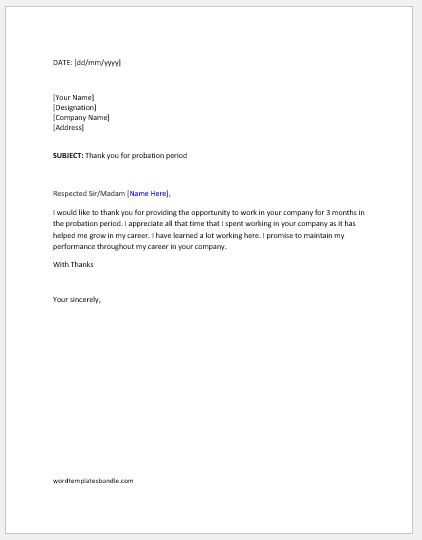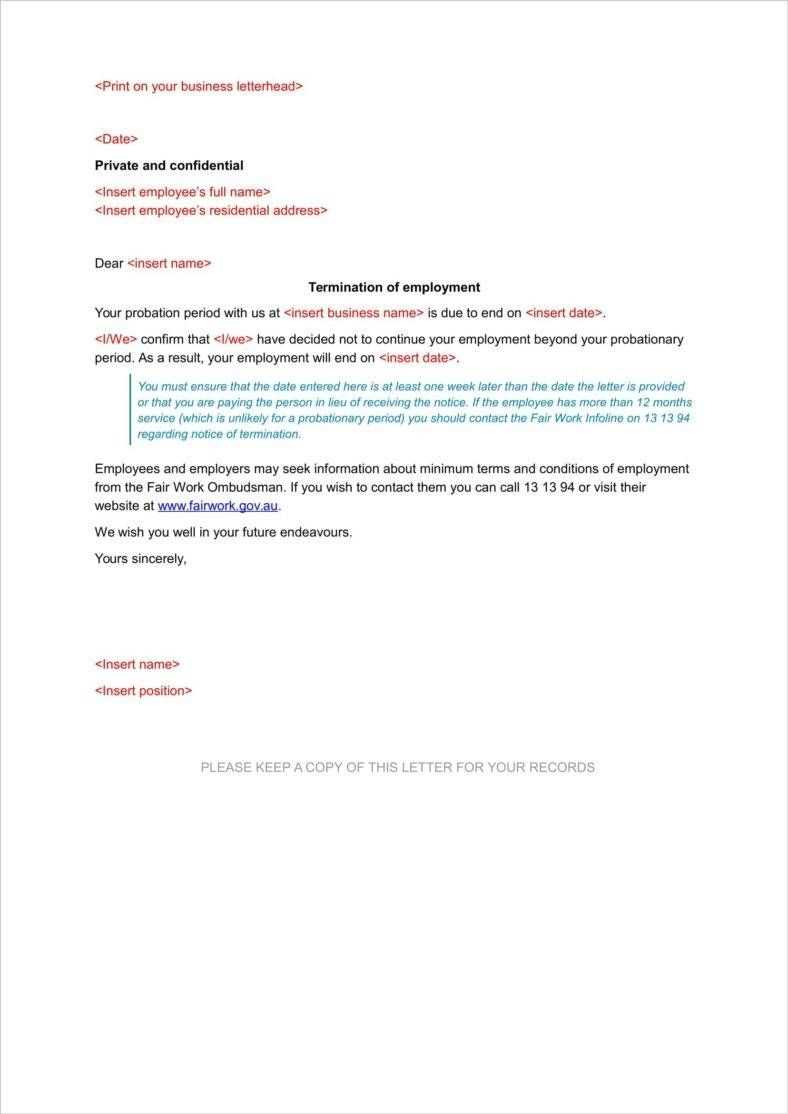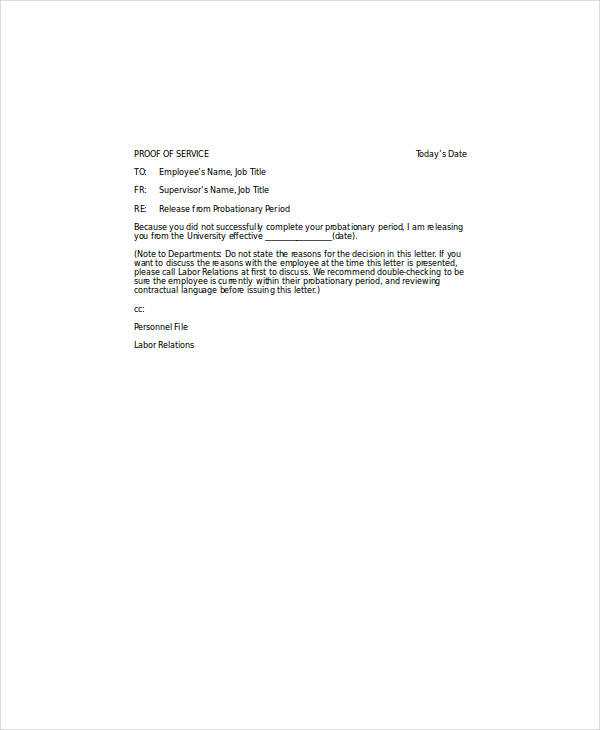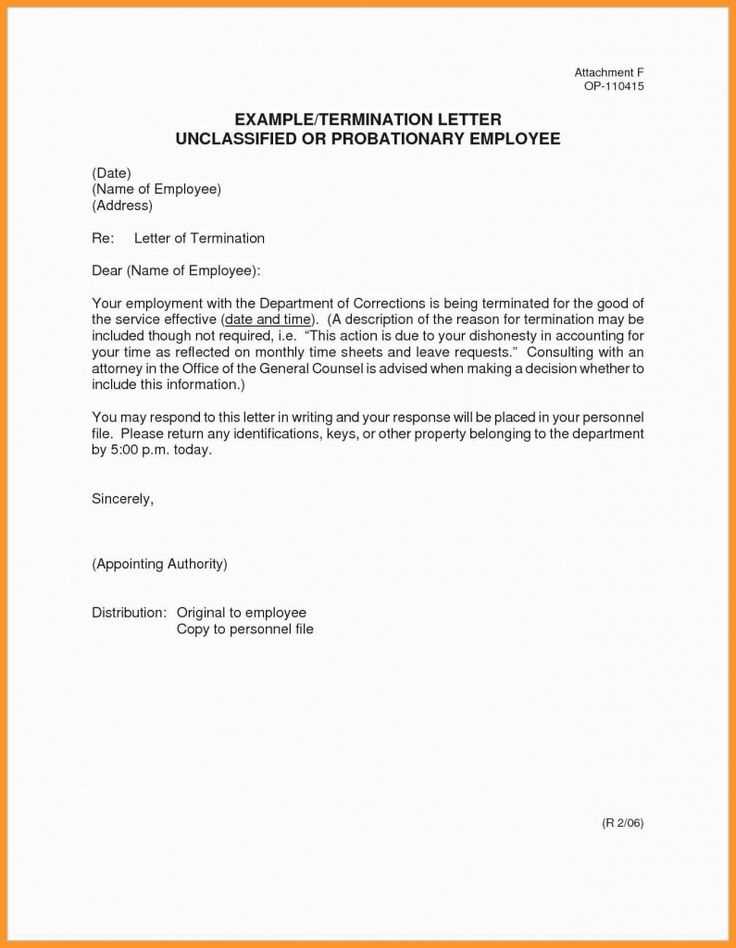Termination Letter Template for Probation Period

When ending an employment relationship during the initial evaluation phase, it’s essential to communicate the decision clearly and professionally. A well-crafted communication document ensures that both the employer and employee understand the reasons and consequences of the decision. It helps protect both parties legally and reduces the potential for misunderstandings.
Why Clear Communication is Crucial

Effective communication in such situations is key to maintaining professionalism. By providing a formal notice, the company can ensure a smooth conclusion to the working arrangement. This document serves as a reference for both parties in case of future disputes or misunderstandings.
Key Information to Include
- Employee Details: Full name, position, and employment dates.
- Reason for the Decision: A brief explanation without unnecessary detail.
- Final Work Day: Specify the last day of employment and any necessary transition steps.
- Any Legal Requirements: Ensure compliance with local labor laws or company policies.
Best Practices for Writing the Document

When drafting the notice, it’s important to keep the tone professional and respectful. Avoid overly emotional or personal language and focus on the facts. Always ensure the document is clear, concise, and devoid of ambiguity.
Handling Employee Reactions
Employees may feel surprised, disappointed, or even upset upon receiving this communication. It’s important to prepare for a calm and respectful discussion, should the employee wish to seek clarification or express their feelings. Maintain a professional demeanor and provide any necessary support during the transition process.
Example of a Professional Notice

Here’s a simple example of what such a document might look like:
[Employee Name] [Position] [Company Name] [Date] Dear [Employee Name], We regret to inform you that your employment with [Company Name] will be ending, effective [Date]. The decision has been made based on the evaluation of your performance during the initial phase of your employment. Your last working day will be [Date], and all company property should be returned by this time. We wish you all the best in your future endeavors. Sincerely, [Your Name] [Your Title] [Company Name]
Crafting a thoughtful and professional document is essential to ensure both clarity and respect for the employee’s dignity, regardless of the situation.
Handling Employee Departure Notices
When concluding an employment relationship during the trial phase, it’s essential to provide a clear and professional document outlining the decision. This helps to ensure mutual understanding and reduce any potential confusion for both the employer and the employee. Properly drafted communication is important for maintaining professionalism and protecting both parties legally.
Importance of a Clear Resignation Notice
A well-structured resignation notice is critical for transparency. It outlines the final decision in a straightforward way, reducing the chances of misunderstandings. This type of communication should be concise, clear, and leave no room for ambiguity. It is a formal document that ensures both the company and the individual are on the same page moving forward.
Essential Information to Include in Your Document
It’s important to cover specific details when creating the document. Key elements should include:
- Full name and position of the employee
- Effective date of the decision
- Reason for ending the employment
- Final day of work and any necessary transitions
- Details of any compensation or benefits owed, if applicable
- Legal disclaimers or compliance information, if required
By including these elements, the document will have a clear purpose and will provide all necessary details for both parties.
Steps to Creating a Professional Notice
Drafting a formal notice requires care. Start by stating the employee’s name and position, followed by the effective date of the decision. Clearly explain the reason for the decision without going into unnecessary detail. Always maintain a professional tone, and ensure the document is both polite and straightforward. Close by thanking the employee for their time and wishing them the best in their future career.
Common Errors to Avoid in Resignation Documents
Some common mistakes to avoid when drafting such documents include:
- Using emotional or subjective language
- Failing to provide a clear reason for the decision
- Being vague about the final work day or transition steps
- Omitting important legal or contractual information
- Not being respectful or professional in tone
These errors can create confusion or even potential legal issues, so it’s important to carefully check the document before finalizing it.
How to Address Employee Responses
Employees may have emotional reactions to such communications, ranging from confusion to frustration. It’s crucial to address these responses in a calm, professional, and empathetic manner. Offer clarification if necessary, and ensure that the employee understands the reasons behind the decision. Be open to feedback, but always maintain professionalism in any further conversations.
Sample Examples for Employment Resignation Notices
Below is an example of a simple resignation notice for reference:
[Employee Name] [Position] [Company Name] [Date] Dear [Employee Name], We regret to inform you that your employment with [Company Name] will conclude, effective [Date]. This decision has been made following the review of your performance during the initial employment phase. Your last working day will be [Date], and any company property should be returned by this time. We appreciate your time and efforts during your tenure and wish you the best in your future endeavors. Sincerely, [Your Name] [Your Title] [Company Name]
Creating a professional and respectful document is essential to ensure both clarity and a smooth transition for both the employer and the employee.